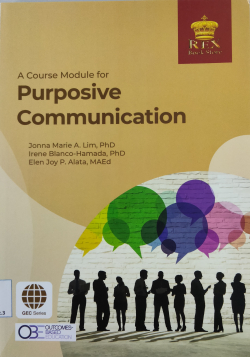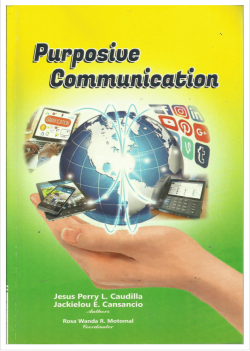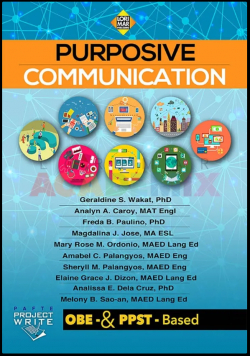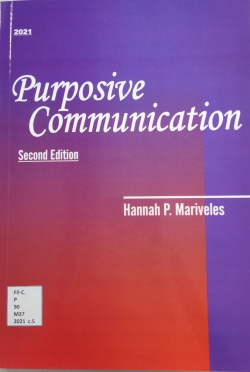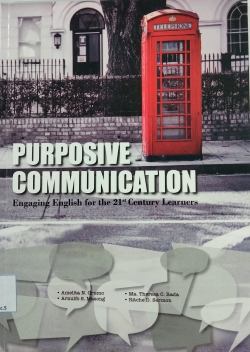Communication for society: purposive communication
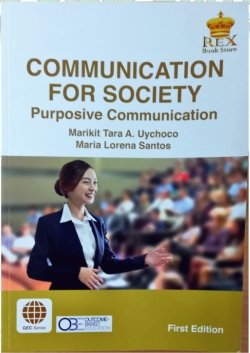
Buy online ($)
Type
Book
ISBN 13
9789712386688
Category
Filipiniana-Circ.
[ Browse Items ]
Publication Year
2018
Publisher
Rex , Philippines
Pages
xii, 232 p. : ill.
Subject
1. Communication. 2. Public speaking.
Abstract
Communication for society: purposive communication is a tertiary-level textbook for the General Education course purposive communication, as required by the Commission on Higher Education (CHED) of the Republic of the Philippines.
The course description is "Writing, speaking, and presenting to different audiences and for various purposes." The five skills of communication (listening, speaking, reading, writing, and viewing) are studied and stimulated in advanced academic settings, such as conversing intelligently on a subject to impart, reporting on group work or assignments , writing and delivering a forma speech, writing minutes of meetings and similar documents, preparing a research or technical paper, and making an audio-visual or web-based presentation. In the process, the criteria for effective communication are discussed and used as the basis for peer evaluation of communication techniques by public officials, educators, industry leaders, churches, and private individuals. The purpose of these combined activities is "to enable students to practice strategies of communication with a clear purpose and audience in mind, guided by the criteria of effective communication and the appropriate language" (CHED, 2013).
In addition, "At the end of the course, students should be able to listen, comprehend, critique, and respond to live or recorded conversations, speak in public with confidence, explain extended texts in their own words using examples and other aids to bolster their explanation, write texts ranging from a simple report to a full-length technical or research paper (scientific, social science, or literary depending on the student's major), and prepare an audio-visual or web-based presentation on an assigned topic" (CHED, 2013).
The course is both pragmatic and aspirational: it helps students using English language skills to gain and share knowledge and insights with different discourse communities in the Philippines, as well as in using these skills to create and critique knowledge for the good of Philippine society.
The general objectives of the course, as encapsulated in this textbook, are the following:
1. To help students become problem-solvers, change agents, and knowledge workers and creators in Philippine society
2. To make students appreciate and articulate individual and societal concerns in the social, academic, and corporate level
3. To encourage students to appreciate and articulate societal issues and concerns in public speaking
4. To ensure that students critically read and write texts using old and new technologies
]
It primarily uses the outcomes-based education (OBE) approach, Dr. William Spady and Dr. Francis Uy, in their book Outcome-Based Education: Critical Issues and Answers, mention ten components of the OBE paradigm in the Intonation age, as opposed to the traditional paradigms set during the industrial age. Although all of the ten components are important and will be followed in this textbook, there are several components that will be essential in the philosophical and pedagogical approaches used in this book.
The first component is Concept Integration (rather than Content Segmentation), wherein exit outcomes take the forms of "complex performance abilities that require students to integrate synthesize, and apply a range of diverse content, concepts, and competence to performance tasks" (Spady and Uy, 2014). We also believe that instructional coaching is an equally important component, where the teacher acts as a coach and mentor, to help students perform their best, and to do this in an individualized, performance-based manner. In terms of assessment, we will use criterion validation, with clear rubrics to help students understand the outcomes they are expected to exhibit and how they will be assessed in each task. Lastly, our activities will emphasize the creation of a Cooperative Learning encironment and will rely on a Collaborative Structure in the classroom (Spady and Uy, 2014).
This textbook is divided into two parts. The first unit is entitled "Academic Research for Philippine society'" which envisions the use of communication for the good of society set in the academic context. Since today's world is shrinking because of globalization, this has been framed in local and global contexts, taking into consideration the needs of students to negotiate with different cultures and world Englishes.
The second unit is entitled "Corporate Communication in Philippine Society," which covers corporate culture and communication in the Philippines and the world, and is contextualized within global work trends. Both units consider the kind of writing, speaking, and viewing tasks requires in the academe and the professional world.
The course description is "Writing, speaking, and presenting to different audiences and for various purposes." The five skills of communication (listening, speaking, reading, writing, and viewing) are studied and stimulated in advanced academic settings, such as conversing intelligently on a subject to impart, reporting on group work or assignments , writing and delivering a forma speech, writing minutes of meetings and similar documents, preparing a research or technical paper, and making an audio-visual or web-based presentation. In the process, the criteria for effective communication are discussed and used as the basis for peer evaluation of communication techniques by public officials, educators, industry leaders, churches, and private individuals. The purpose of these combined activities is "to enable students to practice strategies of communication with a clear purpose and audience in mind, guided by the criteria of effective communication and the appropriate language" (CHED, 2013).
In addition, "At the end of the course, students should be able to listen, comprehend, critique, and respond to live or recorded conversations, speak in public with confidence, explain extended texts in their own words using examples and other aids to bolster their explanation, write texts ranging from a simple report to a full-length technical or research paper (scientific, social science, or literary depending on the student's major), and prepare an audio-visual or web-based presentation on an assigned topic" (CHED, 2013).
The course is both pragmatic and aspirational: it helps students using English language skills to gain and share knowledge and insights with different discourse communities in the Philippines, as well as in using these skills to create and critique knowledge for the good of Philippine society.
The general objectives of the course, as encapsulated in this textbook, are the following:
1. To help students become problem-solvers, change agents, and knowledge workers and creators in Philippine society
2. To make students appreciate and articulate individual and societal concerns in the social, academic, and corporate level
3. To encourage students to appreciate and articulate societal issues and concerns in public speaking
4. To ensure that students critically read and write texts using old and new technologies
]
It primarily uses the outcomes-based education (OBE) approach, Dr. William Spady and Dr. Francis Uy, in their book Outcome-Based Education: Critical Issues and Answers, mention ten components of the OBE paradigm in the Intonation age, as opposed to the traditional paradigms set during the industrial age. Although all of the ten components are important and will be followed in this textbook, there are several components that will be essential in the philosophical and pedagogical approaches used in this book.
The first component is Concept Integration (rather than Content Segmentation), wherein exit outcomes take the forms of "complex performance abilities that require students to integrate synthesize, and apply a range of diverse content, concepts, and competence to performance tasks" (Spady and Uy, 2014). We also believe that instructional coaching is an equally important component, where the teacher acts as a coach and mentor, to help students perform their best, and to do this in an individualized, performance-based manner. In terms of assessment, we will use criterion validation, with clear rubrics to help students understand the outcomes they are expected to exhibit and how they will be assessed in each task. Lastly, our activities will emphasize the creation of a Cooperative Learning encironment and will rely on a Collaborative Structure in the classroom (Spady and Uy, 2014).
This textbook is divided into two parts. The first unit is entitled "Academic Research for Philippine society'" which envisions the use of communication for the good of society set in the academic context. Since today's world is shrinking because of globalization, this has been framed in local and global contexts, taking into consideration the needs of students to negotiate with different cultures and world Englishes.
The second unit is entitled "Corporate Communication in Philippine Society," which covers corporate culture and communication in the Philippines and the world, and is contextualized within global work trends. Both units consider the kind of writing, speaking, and viewing tasks requires in the academe and the professional world.
Description
Contents:
Unit I: Academic Research for Philippine Society
Unit II: Corporate Communication in Philippine Society
Unit I: Academic Research for Philippine Society
Unit II: Corporate Communication in Philippine Society
Biblio Notes
Notes:
Includes bibliographical references and index.
Includes bibliographical references and index.
Number of Copies
5
| Library | Accession No | Call No | Copy No | Edition | Location | Availability |
|---|---|---|---|---|---|---|
| Main | 507 |
Fil-C. P90 U93 2018 |
1 | First Edition | Reserve Section | Yes |
| Main | 508 |
Fil-C. P90 U93 2018 |
2 | First Edition | Filipiniana Section | Yes |
| Main | 509 |
Fil-C. P90 U93 2018 |
3 | First Edition | Filipiniana Section | Yes |
| Main | 510 |
Fil-C. P90 U93 2018 |
4 | First Edition | Filipiniana Section | Yes |
| Main | 511 |
Fil-C. P90 U93 2018 |
5 | First Edition | Yes |
